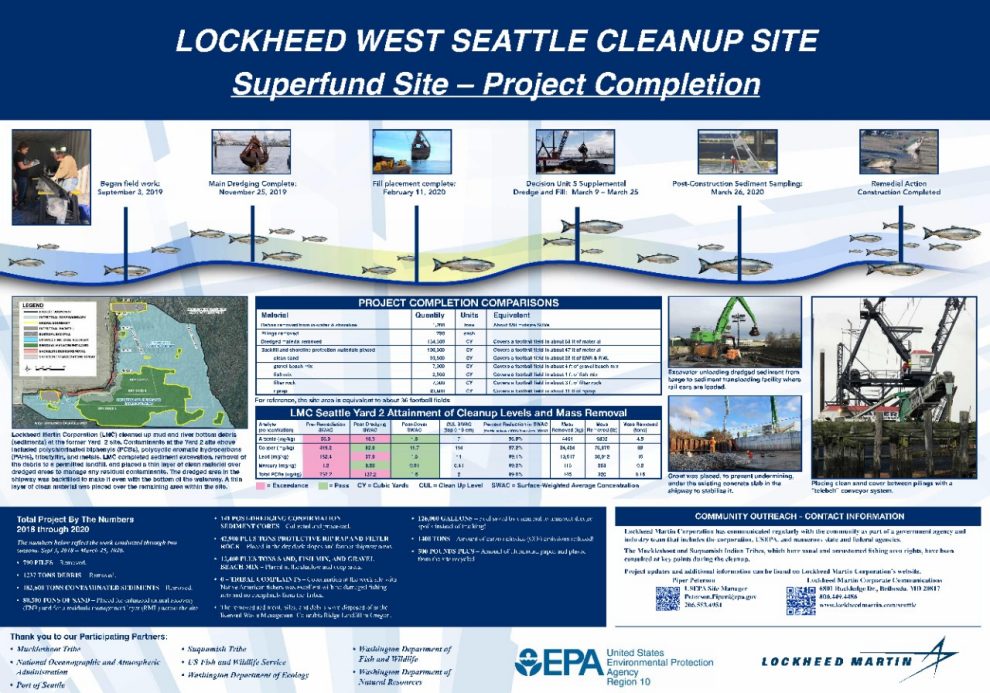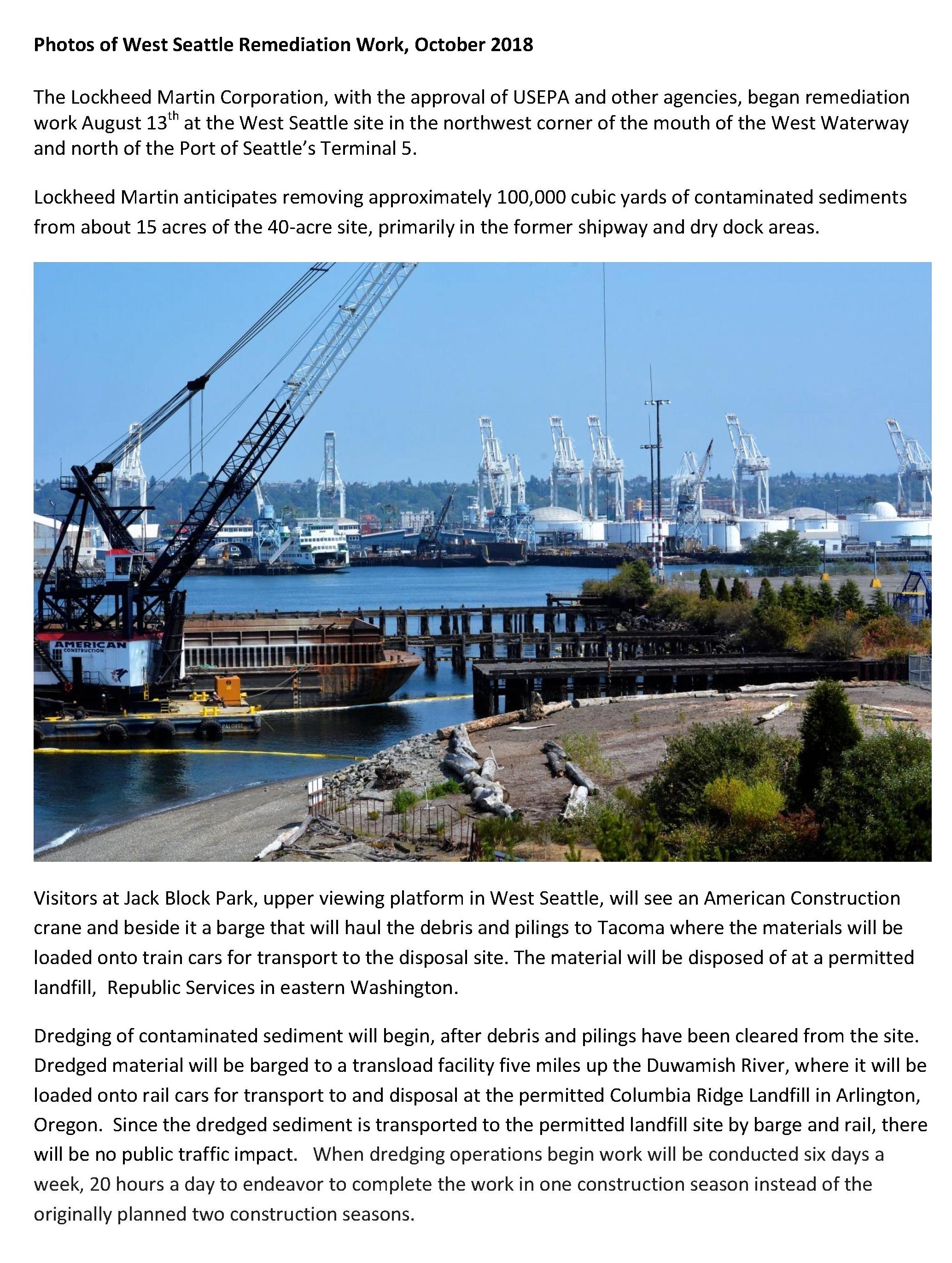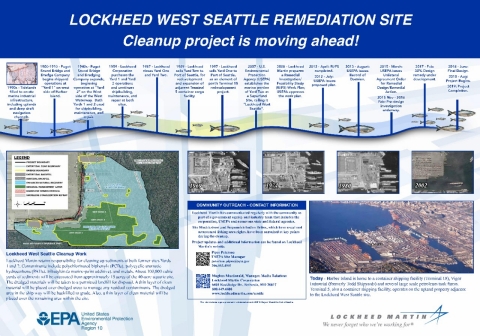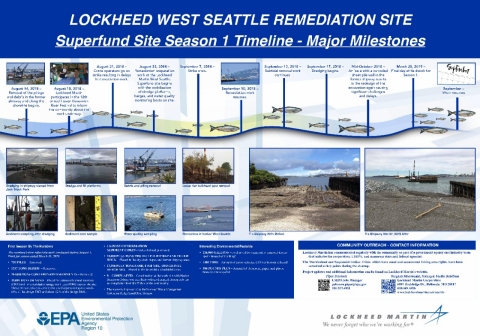Seattle Clean-Up Timeline 2020
UPDATE - 2020
US-EPA Accepts Lockheed West Seattle Superfund Site Remedial Action Construction and Completion (RACCR) Report – September 2020
The US Environmental Protection Agency (EPA) - Seattle Region 10 has documented acceptance of the Remedial Action Construction and Completion Report (RACCR) for the Lockheed West Seattle Superfund Site, Seattle, Washington, effective September 30, 2020.
Remediation of the site cleanup was designed by the Lockheed Martin Corporation. The work was overseen by US-EPA Region 10. Remediation actions were substantively completed in March 2020. There was on-going work regarding institutional controls (covenants).
The remaining activities on this site are identified in the EPA approved Remedial Action Work Plans for Long-term Maintenance and Monitoring and Institutional Control Implementation and Assurance Plan (Lockheed, 2018).
These covenants are required for owned and/or managed property parcels by the Port of Seattle and the Washington Department of Natural Resources.
Five-year reviews are required for the site starting in August 2023.
The report and confirming memo are available for public review at these links: Remedial Action Construction and Completion Report (RACCR) for the Lockheed West Seattle Superfund Site, Seattle, Washington, effective September 30, 2000; US-EPA Confirmation Memo.
History
Elliott Bay is used for a variety of recreational purposes, including fishing, canoeing and kayaking. The Muckleshoot and Suquamish Native American Tribes use the area for commercial and subsistence fishing. The area also provides habitat critical to Chinook salmon, which the federal government has listed as a threatened species.
Lockheed Shipbuilding and other maritime companies operated the former shipyard for approximately 45 years. Lockheed Martin Corporation discontinued its operations at the Lockheed Shipyard No. 2 in 1987.
Discovery
It is believed that historical uses of the facility — shipbuilding, repair and maintenance activities — have resulted in contaminated sediments.
The sediments are habitat to numerous fish and other aquatic species, and are within a migratory corridor for endangered, threatened and other anadromous fish, which are fish that move from salt to fresh water to lay their eggs.
Historical shipyard contaminants of potential concern include
- polychlorinated biphenyls (PCBs)
- polycyclic aromatic hydrocarbons (PAHs)
- organic compounds, mercury and other metals.
- Other contaminants not directly associated with shipyard activities also may be present at the site.
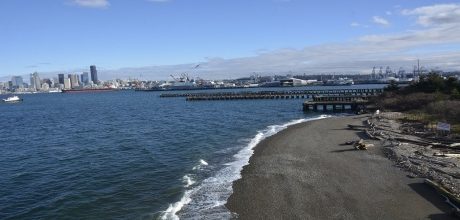
Elliot Bay
The Port of Seattle
The Port of Seattle (The Port) purchased the property in 1992.
- The Port cleaned up the land area of the old shipyard under Washington State Department of Ecology oversight.
- The property is currently part of The Port’s Terminal 5, which is a container shipping facility.
- Lockheed Martin is responsible for cleanup of the aquatic sediments portion of the property, and the U.S. Environmental Protection Agency (EPA) is overseeing this activity.
Investigation
Lockheed Martin has prepared a Remedial Investigation/Feasibility Study (RI/FS) to better understand the contamination and to develop a cleanup plan.
- The EPA approved the work plan in June 2008. To date, Lockheed Martin has conducted three RI field investigations at the site to provide data for the risk assessments and the RI/FS.
- Lockheed Martin conducted an analysis of data collected during the field investigations to complete the Human Health and Ecological Risk Assessments.
- Activities in 2009 and 2010 included the completion of the RI/FS; the EPA determination of the proposed plan; and Record of Decision.
Community Information
If you have questions, please contact Lockheed Martin Communications.
lm.communications@lmco.com
800.449.4486
Seattle Clean-Up Timeline 2019
Superfund Site Season 1 Timeline and Major Milestones 2019
Remediación De Lockheed Martin Seattle Oeste Ficha Técnica Verano 2018
Timeline
1900s - Harbor Island created from wetlands; used continuously for industrial activities.
1909 - Yard 1, on Harbor Island, east side of West Waterway of Duwamish River begins operations as Puget Sound Bridge.
1943 - Yard 2, on the west side of the West Waterway begins operations. Both yards used primarily for shipbuilding, ship repair and maintenance.
1959 - Lockheed buys Yard 1.
1987 – Yard 1 operations cease.
1989 - Lockheed sells Yard 2 to Port of Seattle.
1997 – Lockheed sells Yard 1 to the Port of Seattle.
2007 - U.S. Environmental Protection Agency (USEPA) establishes Lockheed West Seattle as Superfund site.
2008 - Lockheed prepares a Remedial Investigation/Feasibility Study (RI/FS) Work Plan; US EPA approves the work plan.
2012 April – RI/FS completed.
2012 July – USEPA issues Proposed Plan.
2013 August – USEPA issues Record of Decision.
2015 March – USEPA issues Unilateral Agreement Order for Remedial Design/Remedial Action.
2015 November – 2016 February – Pre-design investigation underway.
2017 February – 30% Design remedy under development.
2017 May - 60% Design documents released
2018 July – Final 100% Design documents released.
2018 Winter – 2019 Spring - Remedy construction completed.
2020 September - US-EPA Accepts Lockheed West Seattle Superfund Site Remedial Action Construction and Completion (RACCR) Report
2019 Lower Duwamish Festival
View the Seattle West Document Archive
View a List of Terms Commonly Used in Relation to General Environmental Remediation Efforts




